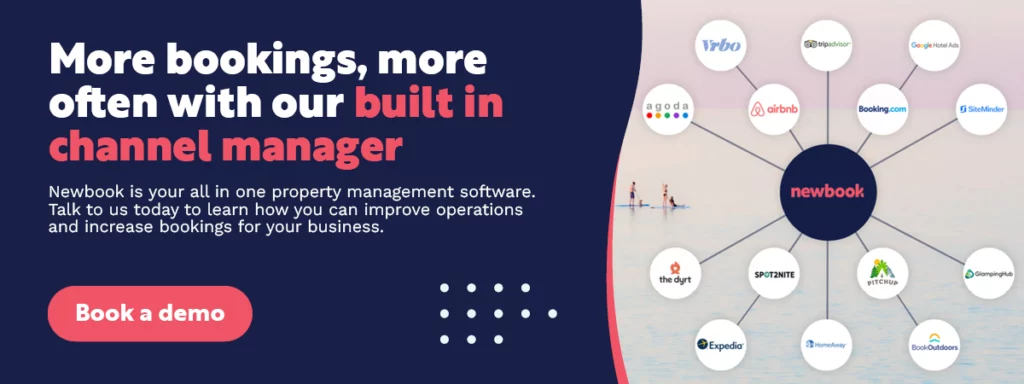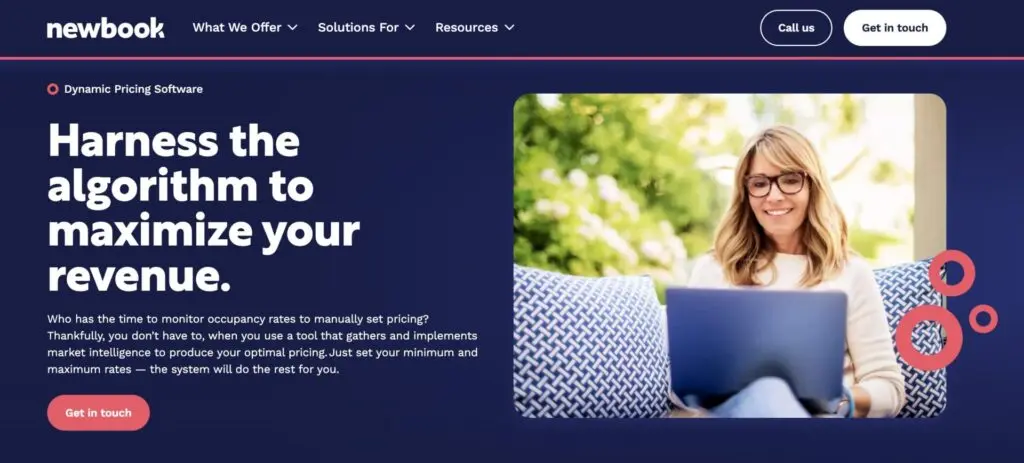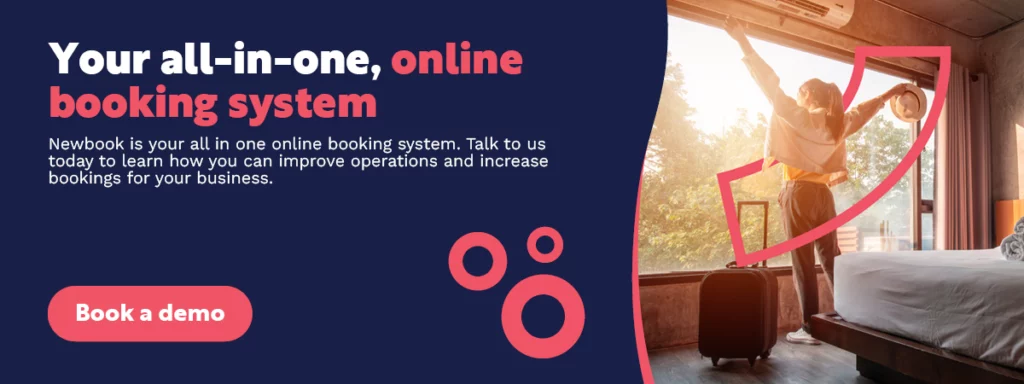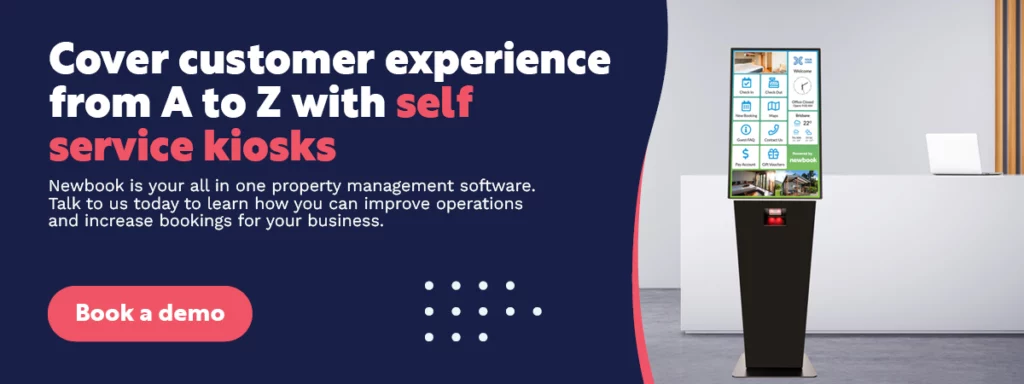So you’ve finally set your prices for the season. After tons of research and manual work looking at competitors, market conditions, and internal data from previous years, you’ve been able to come up with a great pricing strategy that makes sense for your accommodation business, whether it’s an Airbnb, hotel, campground, or RV park.
But one day, you find yourself scratching your head because apparently, there’s an event in town and the prices of all the accommodations around you increased due to the demand—but because you had a manual, set pricing strategy in place, you not only missed out on earning additional revenue but annoyed your competitors with your low prices. Sure, you got more customers out of the deal. Still, given the sudden surge in demand, you had to bring in extra staff and scramble to accommodate more customers than you usually have to deal with at one time without being adequately prepared.
But then the next month, a big storm hits unexpectedly. This means that cancellations are coming at you left, right, and center, and you’re once again left wondering what you could have done differently to prepare for the situation.
One of your competitors, who is also a friend, seems relatively unphased by the sudden changes. When you ask how, they ask if you’ve ever heard of dynamic pricing.
With dynamic pricing software, you can remove the guesswork out of keeping up with your pricing by enabling real-time pricing updates for all your properties automatically. That’s right—instead of constantly analyzing market conditions and staying on top of what your competitors are doing, you can rely on the algorithm to do it for you.
In this article, we take a closer look at dynamic pricing tools, including what they are, why they are important for your accommodation business, the pros and cons of dynamic pricing, and recommendations for choosing an effective dynamic pricing tool of your own.
What Is a Dynamic Pricing Tool?

A dynamic pricing tool is a piece of software that automatically adjusts the prices of hotel rooms, vacation rentals, or other lodging options based on various factors like market demand, seasonality, competitor pricing, and other market conditions in real-time. Dynamic pricing software uses algorithms and internal and external data analytics to optimize pricing strategies with the goal of maximizing revenue and occupancy rates for accommodation providers.
Dynamic pricing solutions continuously analyze information such as:
- Historical booking data
- Upcoming events
- Weather forecasts
- General market conditions
To help accommodation providers set competitive prices that reflect current market dynamics. This approach allows them to capitalize on periods of high demand by raising prices accordingly while also offering discounts or promotions during slower periods to attract more guests. Overall, dynamic pricing software enables accommodation businesses to adapt quickly to changing market conditions and maximize their revenue potential.
Features of Dynamic Pricing Vacation Rentals Tools
The specific features of dynamic pricing software can vary depending on the vendor offering it. There are some general features that you can expect from any offering. These common features include:
- Real-time data analysis: Dynamic pricing software collects and analyzes real-time data on factors such as demand, competitor pricing, booking patterns, and market trends. Using this information, the software can automatically adjust your pricing to suit current market conditions.
- Demand forecasting: The software forecasts demand for future dates, allowing providers to anticipate fluctuations in occupancy and adjust prices accordingly. For example, intelligent dynamic pricing software can recognize patterns and trends in the market. If demand recedes during certain months of the year, it can automatically lower prices to make your accommodations more appealing.
- Competitor analysis: Provides insights into competitors’ pricing strategies, allowing providers to adjust their prices to remain competitive.
- Customizable pricing rules: Allows providers to set rules and constraints to tailor pricing strategies based on specific criteria, such as minimum stay requirements, booking lead time, and room type. With Newbook, you can simply set a minimum and maximum price for the software to stay between.
- Integration with channel managers and PMS: Integrates with property management systems (PMS) and channel managers to automate price updates across distribution channels such as OTAs (Online Travel Agencies) and direct booking websites. With Newbook, the dynamic pricing software is already integrated with the entire PMS suite of tools, so you can ensure that the different aspects affecting your pricing strategy are already considered in your dynamic pricing software.
- Performance reporting: Provides reporting and analytics on pricing performance, including revenue generated, occupancy rates, and other key metrics, to evaluate the effectiveness of pricing strategies.
- Dynamic rate recommendations: Offers suggestions and recommendations for adjusting prices based on current market conditions and performance goals.
- User-friendly interface: Intuitive interface for easy setup and management of pricing strategies, with features such as drag-and-drop functionality and customizable dashboards.

The Importance of AirBnB Dynamic Pricing
When you’re running a business like an AirBnB, one of the most important things you can do is create an effective pricing strategy. Pricing your unit(s) effectively, especially when the vast majority of your guests are going to be finding your business online, is the main way that you’ll be able to lock in bookings and increase your revenue.
Determining the minimum and maximum prices for your units is a crucial first step in implementing dynamic pricing for your business. Dynamic pricing software like Newbook helps you do this by providing you with current and historical internal data, like occupancy rates, customer reviews, booking history, and more, alongside external analysis of market rates, patterns, and trends to help you determine a baseline price. From there, you’ll gather information over time and be able to adjust your pricing as needed.
Dynamic pricing tools are also useful for managing OTAs. Given that two out of three travelers use OTAs to book trips online, not taking advantage of the power of these online travel agencies in bringing you new and repeat customers would mean leaving money on the table. Since most platforms only charge you when a customer books with you, taking advantage of OTAs is also a great way to increase your business’s online reach.
However, managing the pricing of each of your units individually with each OTA platform can quickly become a more than full-time job. Thankfully, most dynamic pricing software (Newbook included) has the ability to seamlessly sync with channel management software, meaning that when your dynamic pricing software changes a price, it is automatically updated on every OTA that you use. This eliminates the need for manual management and ensures your pricing is accurate and consistent on every platform.
Benefits of Dynamic Pricing for Airbnb
Dynamic pricing can offer several benefits for Airbnb hosts, helping them optimize their listings and maximize revenue. Here are some key benefits:
- Maximized revenue: Dynamic pricing algorithms analyze demand, local events, seasonality, and other factors to adjust prices in real time. This helps hosts capture the maximum value from each booking, optimizing revenue.
- Increased occupancy rates: By adjusting prices dynamically, hosts can attract more bookings during low-demand periods, maximizing occupancy rates and reducing the number of empty nights.
- Competitive pricing: Dynamic pricing software monitors competitor listings and adjusts prices accordingly to remain competitive in the market. This helps hosts attract guests and maintain a strong presence on the platform.
- Optimized pricing strategies: Dynamic pricing software provides insights and recommendations on pricing strategies, helping hosts set prices that align with market conditions and their business goals.
- Time savings: Automating pricing adjustments saves hosts time and effort that would otherwise be spent manually monitoring and adjusting prices. This allows hosts to focus on other aspects of hosting, such as guest communication and property maintenance.
- Flexibility: Dynamic pricing software allows hosts to set rules and constraints for pricing adjustments, such as minimum and maximum prices, minimum stay requirements, and pricing adjustments for special events or holidays. This flexibility enables hosts to tailor pricing strategies to their specific needs and preferences.
- Data-driven insights: Dynamic pricing software provides hosts with valuable data and insights into booking trends, demand patterns, and competitor pricing. This information helps hosts make informed decisions about pricing and marketing strategies.
- Improved performance: By optimizing pricing and occupancy rates, dynamic pricing software can help hosts improve the overall performance of their listings on Airbnb, leading to higher ratings, increased visibility, and more bookings in the long run.
Why You Need an Airbnb Dynamic Pricing Tool
Dynamic pricing is very much a culmination of yield pricing and price elasticity. With yield pricing, the supply and demand of a service (in this case, accommodations) directly affects the price. If you need to get home after a popular concert, the price of an Uber or Taxi will be a lot more than on a night when nothing is happening in your city. This is because the demand for the service is higher, which directly impacts its price—people are willing to pay more for the service during these times, meaning that the price is elastic.
Traditionally, yield management only looks at historical data like seasonality to predict demand. An Airbnb dynamic pricing tool can look at the same variables as yield management software. Still, it can look at data minute-by-minute, considering the ebbs and flow of customer demand in real-time to set effective prices. This allows you to set the most appropriate prices based on current events rather than relying entirely on historical data.
Pros and Cons of a Dynamic Pricing Engine
Dynamic pricing software offers several benefits for accommodation providers, but there are also potential drawbacks to consider. Here are some pros and cons to keep in mind when using the software:
| Pros of Dynamic Pricing Software | Details |
|---|---|
| Maximized revenue opportunities | Dynamic pricing software can help hotels maximize revenue by adjusting prices in real-time based on demand fluctuations, market conditions, and other factors. This allows hotels to capture the most value from each booking. Most sources suggest that by using dynamic pricing, accommodation providers can increase their revenue by at least 20%. |
| Occupancy optimization | By dynamically adjusting prices to match demand, hotels can optimize occupancy rates, fill rooms during low-demand periods, and maximize revenue during high-demand periods. |
| Competitive advantage | Dynamic pricing software enables hotels to stay competitive by responding quickly to changes in the market and adjusting prices relative to competitors. This helps hotels attract guests and maintain market share. |
| Improved efficiency | Automating pricing adjustments through software saves time and resources for hotel staff, who would otherwise need to manually monitor and adjust prices. This allows staff to focus on other aspects of hotel operations. |
| Customization | Many dynamic pricing software solutions offer customizable pricing rules and parameters, allowing hotels to tailor pricing strategies to their specific business goals and market conditions. |
While dynamic pricing software offers significant advantages in revenue optimization and competitive positioning, hotels must carefully weigh the potential challenges and risks associated with its implementation and use:
| Cons of Dynamic Pricing Software | Details |
|---|---|
| Dependency on data accuracy | Dynamic pricing relies heavily on accurate and up-to-date data on factors such as demand, competitor pricing, and market trends. If the data is inaccurate or incomplete, it can lead to suboptimal pricing decisions. |
| Potential for price wars | In highly competitive markets, dynamic pricing software can contribute to price wars as hotels continuously adjust prices to undercut competitors. This can erode profit margins and devalue the hotel’s brand in the long run. |
| Customer perception | Rapid fluctuations in prices due to dynamic pricing strategies may confuse or frustrate customers, leading to dissatisfaction or distrust in the hotel’s pricing practices. Hotels must communicate transparently with customers to mitigate these concerns. |
| Risk of overpricing or underpricing | Despite sophisticated algorithms, dynamic pricing software is not infallible and may sometimes lead to overpricing or underpricing of hotel rooms. Hotels must closely monitor pricing performance and make manual adjustments as needed to avoid negative consequences. |
What to Consider When Searching for the Best Dynamic Pricing Tools for Airbnb

After understanding the pros and cons of dynamic pricing software, it’s time to choose the tool that will work best for you and your business. Consider the following factors to ensure that you find a solution that meets your needs:
- Accuracy and reliability: Look for dynamic pricing tools that use advanced algorithms and reliable data sources to ensure accurate pricing recommendations. Check for reviews or testimonials from other users to gauge the tool’s performance.
- Customization options: Consider your specific needs and preferences when evaluating dynamic pricing tools. Look for tools that offer customization options, allowing you to set pricing rules, adjust parameters, and tailor strategies to your property and market.
- Integration with Airbnb: Choose a dynamic pricing tool that seamlessly integrates with the Airbnb platform. This ensures that prices are automatically updated on your listings and saves you time and effort.
- Competitor analysis: Look for tools that provide insights into competitor pricing and market trends. This information can help you stay competitive and adjust your prices accordingly to attract more bookings.
- Ease of Use: Opt for a user-friendly dynamic pricing tool that is easy to set up and navigate. Consider factors such as interface design, ease of configuration, and availability of customer support.
- Performance reporting: Choose a tool that offers robust reporting and analytics features, allowing you to track the performance of your pricing strategies over time. Look for tools that provide key metrics such as revenue generated, occupancy rates, and booking trends.
- Pricing structure: Evaluate the pricing structure of dynamic pricing tools, including any subscription fees, commission rates, or additional charges. Make sure the cost is reasonable and aligns with your budget and expected return on investment.
- Customer support: Consider the level of customer support offered by the dynamic pricing tool provider. Look for providers that offer responsive customer support channels, such as email, phone, or live chat, to address any issues or questions that may arise.
- Reputation and reviews: Research the reputation of dynamic pricing tools and read reviews from other Airbnb hosts who have used the tool. Pay attention to feedback regarding reliability, accuracy, customer support, and overall user experience.
- Trial period or demo: Whenever possible, take advantage of free trials or demos offered by dynamic pricing tool providers. This allows you to test the tool’s features and functionality before committing to a subscription.
Why You Shouldn’t Opt for an Open Source/Free Dynamic Pricing Platform
Everybody loves free stuff. And especially today, when the budgets of accommodation providers are already being stretched thin, seeking out free software to fill in the gaps in your pricing strategy can be tempting. But as the old saying goes, you get what you pay for. When it comes to free or open-source software, there are several reasons why it’s probably better to go with a paid version:
- You’ll have to take care of hosting and maintenance costs. If you go for a free, open-source dynamic pricing tool, you’ll quickly realize that you are responsible for all of the back-end stuff you wouldn’t have to worry about with paid software. This includes server space, networking, bandwidth, security, and more. These are the hidden costs of “free” software.
- Upgrades and software issues have to be handled by you. With a free dynamic pricing platform, you’ll need to handle any upgrades and software issues that come your way. Employee unable to make updates to min and max pricing due to an error? You’ll need to find the answer, whether that be through searching online forums or hiring a professional to do it for you.
- Free software is often limited in functionality. Whether you go for open source or the free version of dynamic pricing software that you would otherwise have to pay for, you’re sacrificing features. Many providers will offer a free trial or a free indefinite version of their software to customers to try, but it’s limited on purpose to entice them to move over to the paid version.
Best Dynamic Pricing Software for Vacation Rentals: Newbook

Newbook prioritizes three key aspects in delivering its hotel revenue management solution: driving revenue growth for customers, fostering business development opportunities through partnership, and providing essential functionalities tailored for hotel and resort operations.
As a comprehensive platform, Newbook stands out as a one-stop-shop solution in the market. It offers a wide array of essential functions crucial for managing hotel operations efficiently. Moreover, Newbook recognizes the significance of seamless integration support. With native support for hundreds of platforms such as Quickbooks, Wild Energy, and IDeas, alongside the availability of Open AI for custom integrations, Newbook ensures compatibility and flexibility to meet diverse needs.
Data security and uptime are paramount concerns for Newbook and its customers. With a stringent 99.99% uptime guarantee and robust cyber security and data protection measures, customers can rest assured that their operations remain uninterrupted, safeguarding revenue generation.
Furthermore, Newbook distinguishes itself through its commitment to exceptional customer service. From initial onboarding to ongoing support, Newbook adopts a white-glove approach, ensuring that customers receive personalized attention and assistance. This customer-centric approach fosters strong partnerships, where Newbook is perceived not just as a technology provider but as an integral ally in driving business success.
At first glance, dynamic pricing can seem pretty complicated. Algorithms that analyze data and determine patterns and trends from it to give you pricing recommendations. Sounds very technical, but it’s actually very easy to use.
However, some dynamic pricing tools for Airbnb have limitations. Either the software limits the number of OTAs that integrate with the tool (meaning you can only list with one or two OTAs if you want your pricing to stay consistent on all channels—and why wouldn’t you?) or they underprice your listed properties in order to undercut competitors and encourage more bookings—instead of focusing on getting you, the host, the maximum return on investment.
Newbook has a different approach to dynamic pricing. First, the dynamic pricing engine is fully integrated into the Newbook PMS, eliminating the need for potentially complex integrations. Secondly, Newbook’s channel management system allows for unlimited OTA listings, meaning that the dynamic pricing tool will effectively keep prices updated and consistent on all the platforms you decide to list on. Like most dynamic pricing solutions, you can control the minimum and maximum pricing of your properties with Newbook’s dynamic pricing tool, ensuring that the tool never goes below or above what you want it to. However, the reporting function provides actionable insights that you can use to determine how and when to adjust your pricing based on the data it presents and your own experience.

Newbook is also much more reliable than most PMS and dynamic pricing software offerings on the market. While most tout a 99% uptime guarantee, Newbook clocks in at 99.99%. This translates to:
- 99%—An outage of 3 days, 15 hours, and 39 minutes annually
- 99.99%—An outage of 52 minutes and 35 seconds annually
Conclusion
Dynamic pricing software offers a powerful solution for accommodation providers, including Airbnb hosts, to optimize their pricing strategies and maximize revenue. By automating pricing adjustments based on real-time data analysis, dynamic pricing tools enable hosts to capture the maximum value from each booking, optimize occupancy rates, and stay competitive in the market.
However, it’s essential to carefully consider factors such as accuracy, customization options, integration with Airbnb, and pricing structure when choosing the best dynamic pricing tool for your business. While free or open-source options may seem appealing, they often come with hidden costs and limitations, making paid solutions like Newbook a more reliable and comprehensive choice. With its integrated approach and robust features, Newbook stands out as an effective dynamic pricing solution for vacation rentals, offering hosts the flexibility, insights, and control they need to succeed in today’s competitive hospitality industry.
Reach out to us today to book a demo or get in touch with a sales representative.


